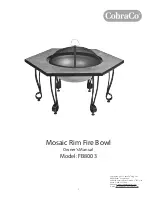
48
PNEG-308
Purafire
14. Pipe Sizing Guidelines
All gas appliances require a specific amount of gas to operate properly. The amount is measured in
BTU’s/Hr and is listed on the appliance’s nameplate. It is important that all regulators and supply piping
be sized correctly to achieve the proper flow (volume) of gas to the appliance.
Regulators
Regulators are devices that control the delivery pressure to the appliance. They are designed to take a
varying inlet pressure and provide a steady delivery pressure. Every regulator has a maximum pressure
rating and volume capacity. Only use regulators that can handle the requirements of the installation.
Regulators typically come in two (2) styles: Primary and secondary. The primary regulators typically
convert higher pressures down to medium pressures, for example, 50 PSI to 10 PSI. They are usually
supplied by the local gas or utility company. Secondary regulators typically convert medium pressures
down to low pressures, for example, 10 PSI to 14" of water column. (1 PSI is equal to 28" of water
column (28" W.C.)).
All regulators have a vent that allows the internal diaphragm to “breathe” freely. This vent must be
protected from the rain, dirt and insects. A clogged vent will slow the regulator’s performance and could
result in over firing of equipment or nuisance locking of the gas valve. If regulators are installed inside
the building, they must be vented properly to the outdoors unless they are equipped with a vent-limiting
device. The vent-limiting device controls the amount of gas that could leak into the atmosphere in case
of a punctured diaphragm. However, regulators that are equipped with vent-limiting devices are position
sensitive and must be installed according to the manufacturer’s recommendations to achieve proper
regulator performance. Refer to the regulator’s instruction page for more information.
In general, the regulator will perform best when its inlet pressure is near the regulator’s maximum rating
and is placed as close to the appliance as possible. The gas valve on the heater uses an electric solenoid
to open and close the gas flow. Because the solenoid operates much more quickly than the mechanical
lever in the regulator, an increase of pressure will occur in the piping between the heater and the
regulator when the heater shuts down. This is called the “lock-up pressure”. If the lock-up pressure
exceeds the gas valve’s maximum, the valve will “pressure-lock”. This is a condition where the solenoid
does not have sufficient power to overcome the pressure to open the valve. If the pressure is relieved,
the gas valve will operate normally. The lock-up pressure can be kept to a minimum by increasing the
inlet pressure to the regulator, ensuring that the vent is working properly, and by placing the regulator
close to the appliance.
When checking and setting pressures, it is important to have ALL gas appliances running. This ensures
that the adequate volume of gas will be available under any conditions. If all appliances are not running
when pressures are checked, false reading could lead to improper settings. This could cause inefficient
combustion and intermittent problems with the heater. It is important to note that propane tanks must be
sized to match BTU requirements of an installation. A tank that is not sized correctly will frost up and not
provide the proper pressure to the appliance. This often occurs at night when the temperature is lower.
The lower temperatures cause the building’s heater to run more often. This causes an increase demand
on the propane supply. Because the propane tank cannot produce as much pressure when it is cooler
(or when the propane level is low), the heaters may not work properly. Contact the local supplier for
information concerning tank sizing.
Содержание C225
Страница 21: ...PNEG 308 Purafire 21 6 Wiring Diagrams 120V Models Figure 6A...
Страница 22: ...22 PNEG 308 Purafire 6 Wiring Diagrams 220V Models Figure 6B...
Страница 23: ...PNEG 308 Purafire 23 7 Wiring Harness Wiring Harness Assembly Figure 7A...
Страница 32: ...32 PNEG 308 Purafire 11 Parts List C225 NG LP Galv Purafire 120V 60 Hz...
Страница 34: ...34 PNEG 308 Purafire 11 Parts List C225 X1 NG LP Galv Purafire 220V 50 60 Hz...
Страница 36: ...36 PNEG 308 Purafire 11 Parts List C80M NG LP Galv Purafire 120V 60 Hz...
Страница 38: ...38 PNEG 308 Purafire 11 Parts List C80M X1 NG LP Galv Purafire 220V 50 60 Hz...
Страница 56: ...56 PNEG 308 Purafire NOTES...











































